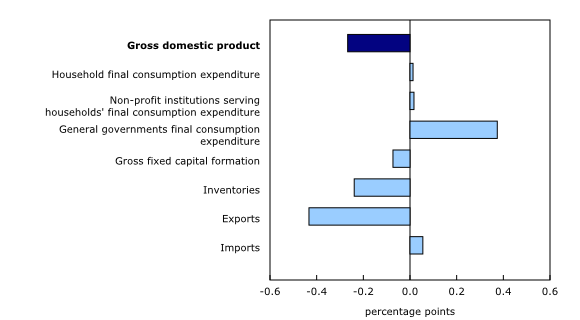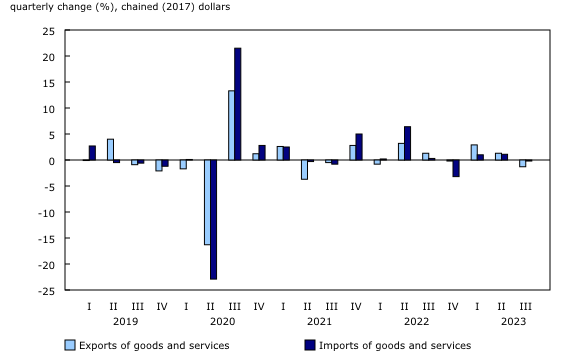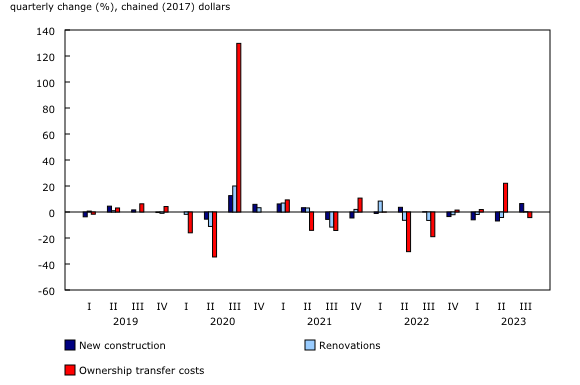Real gross domestic product (GDP) declined 0.3% in the third quarter, following a 0.3% increase in the second quarter. The decrease in international exports and slower inventory accumulation were partially offset by increases in government spending and housing investment. Final domestic demand increased 0.3%, following a similar increase in the second quarter.

Lower exports led to a decline in the gross domestic product
Exports of goods and services fell 1.3% in the third quarter after increasing 1.3% in the second quarter. The leading contributor to the decrease was refined petroleum energy products, which dropped 25.4% in the third quarter after rising 23.9% in the second quarter.
Imports of goods and services edged down 0.2% in the third quarter, following a 1.1% increase in the second quarter. The decrease in imports was led by declines in clothing, footwear and textile products, transportation services, and electronic and electrical equipment and parts. These declines were moderated by increased imports of passenger cars and light trucks as well as travel services.
Inventories accumulate at the slowest pace in two years
Slower inventory accumulation in the third quarter applied downward pressure on GDP growth. This was the smallest buildup of inventories since the third quarter of 2021.
Among industries, manufacturers recorded a withdrawal in inventories in the third quarter of 2023 after six consecutive quarters of accumulations. Non-durable manufactured goods posted the largest quarterly withdrawal in inventories since the fourth quarter of 2010, while wholesale inventories withdrew for the first time since the first quarter of 2022. In contrast, retail inventories grew in the third quarter of 2023, primarily due to a buildup in motor vehicle inventories, which more than offset the inventory withdrawals in the manufacturing and wholesale sectors.
New housing construction increased for the first time since early 2022
After five consecutive quarterly declines, housing investment increased 2.0% in the third quarter of 2023. An increase in new construction (+6.5%) was partly offset by a decline in ownership transfer costs (-4.3%), representing resale activity.
Apartment construction had the greatest impact on new construction; costs related to new construction, such as taxes and closing costs upon ownership change, also contributed to new construction investment. New construction was observed across all provinces and the Northwest Territories, with the Atlantic provinces posting the largest increases.
Household spending remains flat
Household expenditure was unchanged in the third quarter, following a flat second quarter. Durable goods increased 1.0%, led by new trucks, vans and sport utility vehicles (+1.9%), as supply chain issues and manufacturing delays eased and inventories were replenished.
Higher household spending on services (+0.3%) was largely offset by declines in spending on non-durable (-0.4%) and semi-durable (-2.8%) goods.
Business investment in non-residential construction and machinery and equipment declines
Business investment in non-residential structures fell 2.0% in the third quarter, led by decreased spending on engineering structures (-2.5%), which declined for the first time since the first quarter of 2022. The near completion of the Kitimat liquified natural gas project contributed to the decline.
Business spending on machinery and equipment fell 3.8% in the third quarter of 2023, following a 4.4% increase in the second quarter. The decrease was led by lower spending on aircraft and other transportation equipment, after a strong growth in aircraft and ships in the second quarter.
Business spending on intellectual property products edged down 0.3% in the third quarter. The decline was led by lower spending on software (-0.8%). However, spending on mineral exploration (+2.8%) nearly offset the decline.
Gross domestic product implicit prices rise on higher export prices
Largely driven by increased prices of exported items (+3.9%), including crude oil and crude bitumen, the GDP implicit price rose 1.8% in the third quarter. The terms of trade, which is the ratio of the price of exports to the price of imports, grew 4.0%, the first increase since the second quarter of 2022.
The implicit price of household final consumption rose 0.8% in the third quarter of 2023, following a 0.9% increase in the second quarter. Higher prices of non-durable goods and services led to the increase. The price index for household final consumption expenditure (excluding food and energy) rose 0.5% in the third quarter, the smallest increase since the first quarter of 2021.
Compensation of employees rises
Compensation of employees rose 1.3% on a nominal basis in the third quarter of 2023, as average earnings and employment increased. Wages and salaries in services-producing industries rose 1.7%, while those in goods-producing industries were flat (+0.0%). The top industry contributors to overall wage growth were professional and personal services, health services, and federal public administration including military services.
Prince Edward Island (+3.2%) and Newfoundland and Labrador (+2.8%) had the largest increases in compensation of employees in the third quarter, followed by British Columbia (+1.9%). After relatively low growth in the previous quarter, the compensation of employees in the Northwest Territories and Nunavut (-1.3%) decreased.
Household saving rate increases
Household net saving (in nominal terms) increased in the third quarter, as a modest gain in household disposable income (+1.0%) surpassed the rise in household spending (+0.8%). Softening labour market conditions and weaker financial market gains relative to the second quarter were counteracted by higher government transfers, which were mainly due to the introduction of the Grocery Rebate on July 5, 2023.
Compensation of employees increased by 1.3% in the third quarter, led by higher property income (+2.9%). Meanwhile, government transfers to households grew by 0.7%, representing the first quarterly increase since the fourth quarter of 2022.
Consequently, the household saving rate reached 5.1% in the third quarter of 2023, up from 4.7% in the second quarter. The household saving rate is aggregated across all income brackets; in general, saving rates are greater in higher income brackets.
Gross operating surplus bounces back
In the third quarter, gross operating surplus rose 2.3% after declining in each of the previous four quarters. Higher gross operating surplus for non-financial corporations was partly offset by a decline in that of financial corporations.
Incomes for the non-financial sector in the third quarter were boosted by higher prices for crude oil and refined petroleum products. Increases in incomes across the entire motor vehicle supply chain also contributed to higher corporate incomes, reflected by increased profits, despite declines in motor vehicle sales in the first two months of the quarter.
Gross operating surplus for financial corporations continued to decline in the third quarter owing to higher insurance claims. Narrowing net interest margins among chartered banks due to the fast pace of central bank policy rate increases also contributed to the decline.
Note to readers
In this article, new benchmark values from the supply-use tables (SUTs) for the 2020 reference year have been incorporated into the gross domestic product (GDP) by Income and Expenditure Accounts (IEA). The SUTs integrate data from a wide range of sources into a balanced accounting framework. They represent the most detailed, coherent accounting system for the structure of the Canadian economy and are considered the most accurate benchmarks on which to base estimates.
Revisions for the 2021 and 2022 reference years incorporate up-to-date information from the Annual Survey of Manufacturing and Logging, the Annual Survey of Research and Development in Canadian Industry, the Annual Census of Mines, Quarries and Sand Pits, government public accounts, and updated administrative data. These revisions also reflect the incorporation of T4 data for 2021 and preliminary T4 data for 2022, which are used to estimate wages and salaries.
Results from the Annual Capital and Repair Expenditure Survey were incorporated for 2021, whereas 2022 estimates were revised to incorporate major project updates from the upcoming 2022 Actual release (February 2024).
Re-referencing of the volume and price estimates
Volume and price estimates for the quarterly GDP and accompanying set of accounts have been updated to the 2017 (2017=100) reference year with this release. Additionally, the international trade classification has been updated to the North American Product Classification System (NAPCS) 2022. Given the inclusion of a more recent NAPCS and reference year, price baskets have been updated.
Accounting for e-commerce transactions with non-resident vendors
The indicators used to estimate household final consumption expenditure have been adjusted to account for non-resident e-commerce sales. The Monthly Retail Trade Survey collects data only on resident vendor e-commerce sales. The non-resident vendor e-commerce adjustment, which is applied to the indicators to estimate household consumption, mainly the Retail Commodity Survey, is a non-seasonally adjusted, quarterly value. This adjustment has been in place since the fourth quarter of 2019. For the third quarter of 2023, the adjustment represents 849.9 million dollars, applied to the household consumption indicators. The adjustment is derived using sources such as details from customs transactions, goods and services tax remittances and financial statements for certain enterprises.
General
Percentage changes for expenditure-based statistics (such as household spending, investment and exports) are calculated from volume measures that are adjusted for price variations. Percentage changes for income-based statistics (such as compensation of employees and operating surplus) are calculated from nominal values; that is, they are not adjusted for price variations. Unless otherwise stated, growth rates represent the percentage change in the series from one quarter to the next: for instance, from the second quarter of 2023 to the third quarter of 2023.










I just like the helpful information you provide in your articles